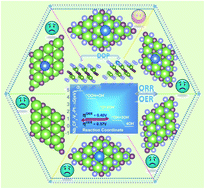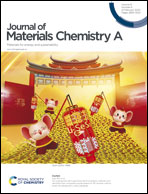Rational design of bifunctional ORR/OER catalysts based on Pt/Pd-doped Nb2CT2 MXene by first-principles calculations†
Abstract
Developing highly active, stable, and conductive bifunctional oxygen reduction (ORR) and oxygen evolution (OER) catalysts is a key step for fuel cells and metal–air batteries. Herein, an effective idea for designing bifunctional catalysts is presented by regulating the surface electronic structures of Nb2CT2 (T = O, F, and OH) using Pt/Pd single atoms. The results indicated that Pt-doped systems (Nb2CO2–VO–Pt, Nb2CF2–VF–Pt) were the most promising bifunctional ORR/OER catalysts. In particular, Nb2CF2–VF–Pt was even better than landmark Pt(111) and IrO2(110) catalysts, with relatively low overpotentials of 0.40 V and 0.37 V for ORR and OER, respectively. The high catalytic nature of Nb2CF2–VF–Pt was explained by electronic structures, volcano plots, and charge transfer mechanisms, which mainly depended on the electron donor capacity and synergistic effects from F-terminated groups and Pt noble metals. Moreover, 100% utilization of Pt was achieved for the designed bifunctional catalysts with a minimum radius between two adjacent active centers. This was the first design of a bifunctional ORR/OER catalyst based on Nb2CT2 and highlighted a new perspective on the application of MXenes.



 Please wait while we load your content...
Please wait while we load your content...